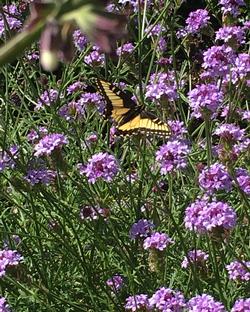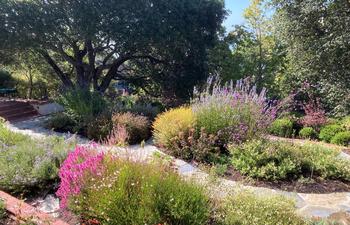A recipe for planting a butterfly garden
-
Alice Cason
-
A butterfly garden can be any size, a few containers in a sunny spot, small beds, or larger areas. UC Marin Master Gardeners recommend a few strategic principles for starting a successful garden project. First, always plant the right plant in the right place. Analyze your garden situation and use available tools and resources for good pollinator habitat.
 Anise swallowtail nectaring on Verbena Lilacina. Considered a California native, it has a long bloom time and low water use. Photo: Alice Cason
Anise swallowtail nectaring on Verbena Lilacina. Considered a California native, it has a long bloom time and low water use. Photo: Alice CasonHaving a vision is important. Make a site plan setting your goals. Map the area to be planted. Find north to see the path of the sun and shade areas. Are there any microclimates or major areas of shade from large trees? Draw in hardscape, large rocks, and permanent structures. Remember that butterflies like warming surfaces, flat rocks, and exposed soil. SITE ANALYSIS: Getting To Know Your Garden - UC Marin Master Gardeners (ucanr.edu)
Healthy soil is an ecosystem. A soil test from a home kit can help analyze the soil’s needs. For example, the pH number can tell if the soil is acidic or alkaline. See the Marin Master Gardeners website for a guide to soil testing and keeping your soil healthy by adding the right amendments: How to Evaluate Soil - UC Marin Master Gardeners (ucanr.edu). Feed the soil, and the plants will be fed naturally. Sequester carbon by maintaining healthy levels of organic matter, compost, and mulch.
Site preparation is essential. Remove weeds and invasives. Sheet mulch with a layer of cardboard to build soil and prevent them from interfering with your new plants. I removed a large lawn by sheet mulching and then added a layer of compost in preparation for planting. The weeds were eliminated. Plan ahead on getting water to the plants, especially in the establishment phase when they may need extra care. Plant California Natives in drifts and in groups of at least 3 of the same variety for the most impact. Photo: Alice Cason
Plant California Natives in drifts and in groups of at least 3 of the same variety for the most impact. Photo: Alice CasonAlways use the botanical names to order plants to prevent errors. Learn about the foliage and the color of the flowers. Is it an annual or a perennial (use both)? What is the mature size? Does the plant need shade or sun? How long will it bloom? What are the water requirements? Arrange plants with similar needs together to make a hydro zone. Once you have these facts, you can estimate the quantity and size of plants. Use the UC Marin Master Gardener website as a resource for pictures and plant descriptions. PLANTS FOR POLLINATORS - UC Marin Master Gardeners (ucanr.edu)
The goal is to create a habitat. Plant a diversity of butterfly host and nectar plants with a variety of shapes, heights, and sizes. Plant masses of bright colors for the most impact. Group plants that bloom in different seasons, spring, summer, and fall, for a seasonal sequence of flowers. California native plants provide nutrition in the form of seeds, berries, sap, nectar, and pollen. They use less water and are easy to maintain once established. Make your garden a safe place to make a nest or find a resting place. Add a water source for drinking with a small shallow dish filled with pebbles for landing pads. A Monarch caterpillar eating its host plant reminds us plants will have insects that eat them and not all insects are bad. Photo: Alice Cason
A Monarch caterpillar eating its host plant reminds us plants will have insects that eat them and not all insects are bad. Photo: Alice CasonNow it is time to go shopping at your local nursery. Make your garden a pesticide-free zone. Be sure to choose plants that have not been treated with neonicotinoids which will affect pollinator health, select disease and pest-resistant varieties that are healthy and free of weeds. It is OK to start small with 4” and 1-gallon plants that are the most economical.
Once established, your butterfly garden will not just be pretty but will add value to the ecosystem and promote biodiversity. As the plants mature, you will have transformed your garden into a wildlife sanctuary. Your landscape can connect to the wildlife corridor around us. Be a citizen scientist and discover what wonders your garden supports. Remember that if you plant it, they will come, one garden at a time.



